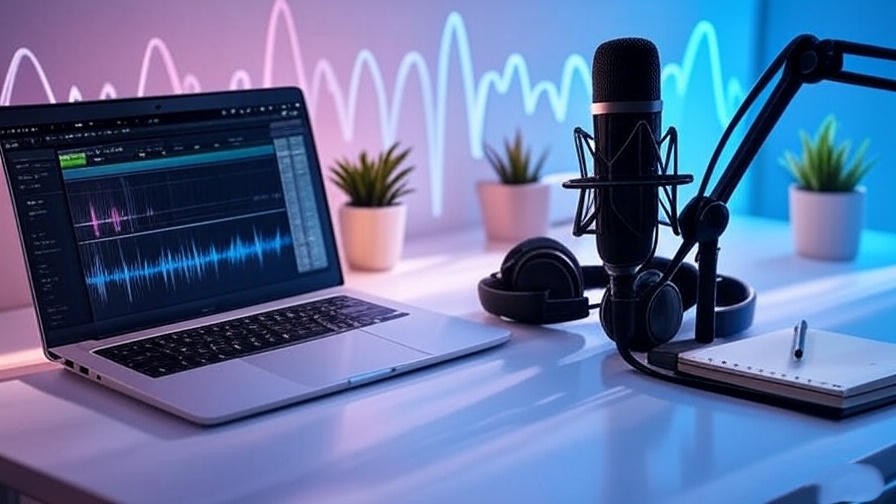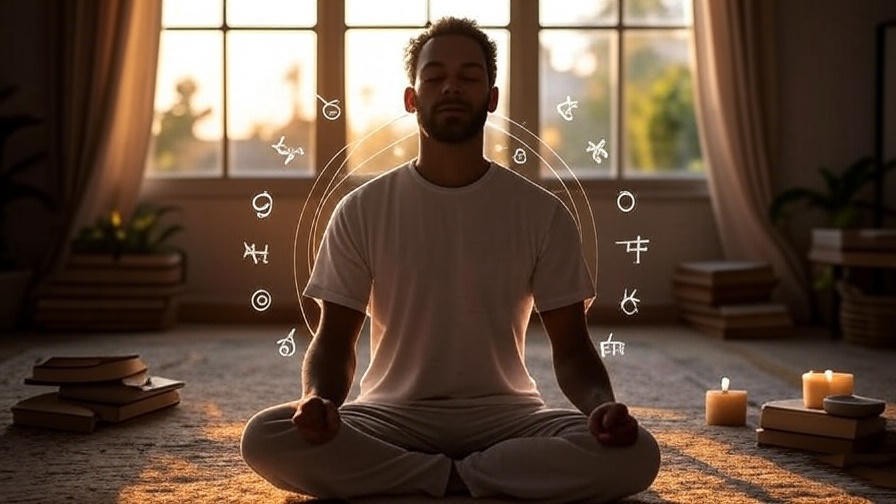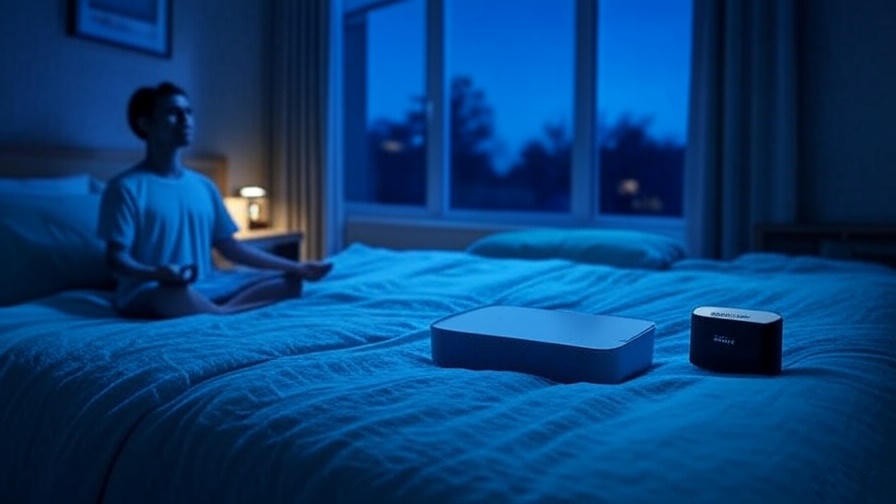Picture yourself lying in bed, stress melting away as a soothing voice guides you into a state of deep relaxation, accompanied by gentle, flowing music. This is the power of a spoken meditation with background music—a transformative tool for better sleep and inner peace. Whether you’re seeking relief from insomnia, anxiety, or simply a moment of calm, crafting your own meditation audio can be a game-changer. In this comprehensive guide, we’ll show you how to turn it into a spoken meditation with background music, step by step, empowering you to create calming audio experiences that nurture your mind, body, and soul. Backed by science and practical tips, this article will equip you with everything you need to start your journey.
Meditation has surged in popularity, with a 2017 National Health Interview Survey showing 14.2% of adults in the U.S. practice it regularly. Its benefits—reduced stress, improved sleep, and enhanced emotional well-being—are well-documented. By combining a guided script with carefully chosen music, you can amplify these effects, creating a powerful tool for holistic wellness. Whether you’re a beginner or an experienced practitioner, this guide will help you craft meditations that resonate deeply with your audience.
Why Spoken Meditations With Background Music Work
The Science Behind Meditation and Sleep

Meditation activates the parasympathetic nervous system, which promotes relaxation and counters the body’s stress response. A 2014 meta-analysis published in JAMA Internal Medicine found that mindfulness meditation can reduce anxiety by up to 40% and improve sleep quality. Spoken meditations guide listeners through this process, using verbal cues to focus the mind and release tension. When paired with background music, the effect is amplified. Music with a tempo of 60-80 beats per minute (BPM) aligns with the resting heart rate, helping to slow breathing and induce a state of calm, as noted in a 2018 study from the Journal of Advanced Nursing.
Benefits for Holistic Well-Being
Spoken meditations with background music offer a range of benefits:
- Improved Sleep Quality: Guided meditations can reduce insomnia symptoms, helping you fall asleep faster and stay asleep longer.
- Stress Reduction: Verbal guidance paired with soothing music lowers cortisol levels, fostering relaxation.
- Emotional Resilience: Regular practice enhances emotional regulation, as shown in a 2020 study from Frontiers in Psychology.
- Inner Peace: Meditations create a sense of calm and self-awareness, supporting holistic well-being.
Real-World Example: Sarah, a 34-year-old teacher, struggled with nighttime anxiety. After listening to a 10-minute spoken meditation with soft piano music, she reported falling asleep within minutes and waking up refreshed. This simple practice transformed her nightly routine.
Understanding the Elements of a Spoken Meditation
The Role of the Voice
The voice is the heart of a spoken meditation. A calm, steady tone can guide listeners into a relaxed state, while a rushed or unsteady voice may disrupt the experience. To cultivate a soothing voice:
- Practice diaphragmatic breathing to maintain a steady, calm tone.
- Record test runs to assess pacing and clarity.
- Speak authentically, as listeners connect with genuine emotion.
Expert Tip: Meditation teacher Dr. Lisa Carter emphasizes, “Your voice doesn’t need to be perfect—it needs to be present. Speak from a place of calm, and your listeners will feel it.”
Choosing the Right Background Music
Background music sets the mood and enhances relaxation. Consider these factors:
- Type of Music: Opt for ambient, nature sounds (like rain or waves), lo-fi, or classical tracks. Avoid vocals or abrupt changes.
- Tempo: Choose music with 60-80 BPM to align with the body’s natural relaxation rhythm.
- Volume Balance: Ensure the music complements, not overpowers, the voice. A good rule is to keep music at 20-30% of the voice’s volume.
Where to Source Music: Platforms like Epidemic Sound, Free Music Archive, or Pixabay offer royalty-free tracks ideal for meditations. Always check licensing to avoid copyright issues.
Structuring the Meditation Script
A well-structured script is key to guiding listeners effectively. Include these components:
- Opening Relaxation: Invite listeners to settle in and focus on their breath.
- Body Scan: Guide them to relax each part of the body, from head to toe.
- Visualization: Use calming imagery, like a serene forest or gentle waves.
- Affirmations: Incorporate positive statements, such as “I am at peace.”
- Gentle Closure: Gradually bring listeners back to awareness.
Example Script Snippet (5-Minute Sleep Meditation):
“Close your eyes and take a deep breath. Feel your body soften as you exhale. Imagine a warm, golden light spreading from your head to your toes, releasing all tension. You are safe, calm, and ready for restful sleep.”
Step-by-Step Guide to Creating Your Spoken Meditation
Step 1: Define Your Meditation’s Purpose
Start by identifying the meditation’s goal. Is it to promote better sleep, reduce stress, or foster emotional healing? Tailor the content to your audience’s needs:
- Beginners: Use simple language and shorter durations (5-10 minutes).
- Advanced Practitioners: Incorporate deeper visualizations or longer sessions.
- Specific Demographics: Create meditations for parents (e.g., calming a busy mind) or professionals (e.g., stress relief after work).
Example: A meditation for new parents might focus on quick relaxation during nap times, while one for professionals could target workday stress.
Step 2: Write a Compelling Script
A great script is clear, concise, and soothing. Follow these tips:
- Use sensory language to engage the imagination (e.g., “Feel the cool breeze on your skin”).
- Include positive affirmations to reinforce calm (e.g., “You are worthy of peace”).
- Keep sentences short and pauses frequent to allow listeners to process.
Sample Script Excerpt:
“Picture yourself in a quiet meadow, surrounded by soft grass and blooming flowers. With each breath, feel your worries drift away, like clouds in a clear sky. You are safe, you are calm, you are enough.”
Step 3: Select and Test Background Music
Choose music that matches the meditation’s mood. For sleep, try soft piano or ocean waves; for stress relief, consider ambient drones or gentle guitar. Use tools like Audacity or GarageBand to:
- Trim music to match the script’s length.
- Adjust volume to ensure the voice remains prominent.
- Test the audio balance with headphones to mimic the listener’s experience.
Pro Tip: Test your meditation on friends or family to ensure the music enhances, not distracts, from the experience.
Step 4: Record Your Meditation
Recording a high-quality meditation is easier than you might think, even with minimal equipment. Here’s how to get started:
- Equipment: A USB microphone like the Blue Yeti or Audio-Technica ATR2100x is affordable and delivers clear audio. Use a pop filter to reduce harsh sounds.
- Environment: Choose a quiet space with minimal background noise. Consider recording in a closet or under a blanket to dampen echoes.
- Recording Tips:
- Speak slowly and deliberately, pausing to allow listeners to absorb your words.
- Record multiple takes to capture the best delivery.
- Use a conversational yet soothing tone, as if speaking to a friend.
- Editing: Use free software like Audacity to remove background noise, trim mistakes, and add fades for smooth transitions. Export the final file as an MP3 for compatibility.
Expert Insight: Sound engineer Jamie Patel notes, “Clarity is key in meditation recordings. A clean, crisp voice with subtle background music creates an immersive experience that listeners trust.”
Step 5: Share and Distribute Your Meditation
Once your meditation is ready, share it with the world. Here’s how:
- Platforms: Upload to YouTube, Insight Timer, Spotify, or SoundCloud. Insight Timer, for example, has over 20 million users and is a popular hub for guided meditations.
- SEO Optimization:
- Use descriptive titles with LSI keywords like “guided sleep meditation,” “calming audio,” or “relaxation music.”
- Add relevant tags (e.g., “sleep meditation,” “guided relaxation,” “inner peace”).
- Create an engaging thumbnail with serene imagery, such as a starry sky or tranquil lake.
- Promotion: Share on social media platforms like Instagram, Pinterest, and X, using hashtags like #Meditation, #SleepBetter, or #Mindfulness. Engage with your audience by responding to comments and encouraging feedback.
Case Study: Meditation creator Emily Hayes uploaded a 10-minute sleep meditation to YouTube, optimized with a clear title and tags. Within a month, it garnered 5,000 views, with listeners praising its calming effect.
Common Mistakes to Avoid When Creating Spoken Meditations
Even with the best intentions, pitfalls can undermine your meditation’s effectiveness. Here are common mistakes and how to avoid them:
- Overcomplicating the Script: Avoid jargon or overly complex visualizations. Keep it simple and relatable, focusing on universal themes like peace or rest.
- Distracting Music: Music that’s too loud or has sudden changes can disrupt relaxation. Always test the balance between voice and music.
- Poor Audio Quality: Background noise or low volume can frustrate listeners. Invest in a decent microphone and edit carefully.
- Lack of Authenticity: Listeners can sense inauthenticity. Speak from the heart, and avoid mimicking other creators’ styles.
Expert Quote: Meditation teacher Dr. Anika Rao advises, “Simplicity is the soul of a great meditation. Focus on creating a safe, welcoming space for your listeners.”
Enhancing Your Meditation With Advanced Techniques
Incorporating Binaural Beats and Solfeggio Frequencies

Binaural beats and Solfeggio frequencies can deepen relaxation by influencing brainwave activity. For example:
- Binaural Beats: These involve playing two slightly different frequencies in each ear, creating a perceived beat that can induce theta waves (4-8 Hz) for relaxation. A 2019 study in Frontiers in Human Neuroscience found binaural beats effective for reducing anxiety.
- Solfeggio Frequencies: Frequencies like 432 Hz or 528 Hz are believed to promote healing and calm. Use them sparingly to avoid overwhelming listeners.
- How to Use: Source royalty-free binaural tracks from platforms like MyNoise.net, and layer them subtly behind your voice.
Personalizing Meditations for Specific Needs
Tailor your meditations to address specific challenges:
- Anxiety: Focus on grounding techniques, like breath awareness or affirmations such as “I release all worries.”
- Grief: Use gentle imagery, like a warm light enveloping the listener, to foster comfort.
- Morning Motivation: Incorporate energizing affirmations, such as “I am ready to embrace this day with confidence.”
Example for Children: “Imagine a friendly cloud carrying you to a cozy, magical treehouse where you feel safe and happy.”
Adding Guided Visualizations
Vivid visualizations enhance the meditative experience. To create effective imagery:
- Use sensory details: “Feel the soft sand beneath your feet as gentle waves lap at the shore.”
- Keep it accessible: Choose universally calming scenes, like a forest or beach, rather than niche settings.
- Allow flexibility: Offer suggestions like “Picture a place where you feel safe” to let listeners personalize the experience.
Example Visualization: “You’re floating on a calm lake, surrounded by twinkling stars. Each breath makes you feel lighter, as if all worries are drifting away.”
Tools and Resources for Crafting Spoken Meditations

To streamline your process, leverage these tools:
- Recording Software: Audacity (free) or Adobe Audition (premium) for editing audio.
- Music Libraries: Epidemic Sound, Free Music Archive, or Pixabay for royalty-free tracks. Ensure licenses allow commercial use if monetizing.
- Scriptwriting Resources: Books like The Healing Power of Sound by Jonathan Goldman or The Miracle of Mindfulness by Thich Nhat Hanh for inspiration.
- Apps for Inspiration: Explore meditations on Insight Timer, Calm, or Headspace to understand structure and tone.
Budget Tip: Start with free tools like Audacity and royalty-free music from Pixabay to keep costs low while maintaining quality.
How to Measure the Success of Your Meditation

Tracking your meditation’s impact helps you refine your craft:
- Engagement Metrics: Monitor plays, likes, shares, and comments on platforms like YouTube or Spotify. Insight Timer provides detailed analytics on listener retention.
- Feedback: Encourage listeners to share their experiences via comments or surveys. For example, ask, “How did this meditation help you relax?”
- Adjustments: If listeners prefer shorter sessions, create 5-minute versions. If they love nature sounds, incorporate more ocean or forest tracks.
Example: After noticing high engagement on a 15-minute sleep meditation, creator Mark Lee produced a series of similar-length audios, boosting his channel’s subscribers by 20%.
Frequently Asked Questions (FAQs)
What’s the ideal length for a spoken meditation?
Most listeners prefer 5-20 minutes, depending on the purpose. Sleep meditations often work best at 10-15 minutes, while quick relaxation sessions can be 5 minutes.
Do I need professional equipment to record a meditation?
No, a USB microphone (e.g., Blue Yeti, $100) and free software like Audacity are sufficient for beginners. Focus on a quiet space and clear editing.
How do I choose the right background music?
Select royalty-free tracks with a slow tempo (60-80 BPM) and no vocals. Test the music to ensure it complements your voice without overpowering it.
Can I monetize my spoken meditations?
Yes, through platforms like YouTube (ad revenue), Patreon (subscriptions), or Insight Timer (donations). Ensure music licenses allow commercial use.
Conclusion
Creating a spoken meditation with background music is a powerful way to promote better sleep, reduce stress, and cultivate inner peace. By following this guide—defining your purpose, crafting a soothing script, choosing the right music, recording with care, and sharing strategically—you can create transformative audio experiences for yourself and others. Start small, experiment with different techniques, and let your authentic voice shine. This week, try recording your first meditation and share it with your community. As meditation expert Jon Kabat-Zinn says, “You can’t stop the waves, but you can learn to surf.” With a microphone, a script, and calming music, you’re ready to create a sanctuary of peace.













